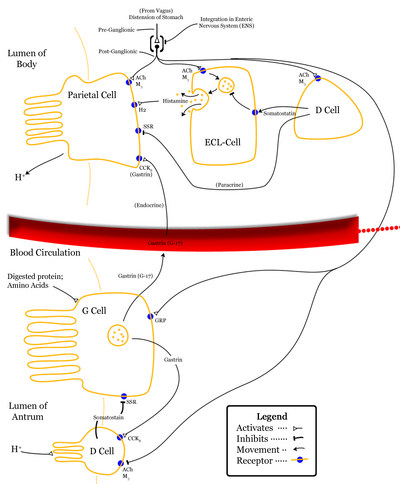Assessment |
Biopsychology |
Comparative |
Cognitive |
Developmental |
Language |
Individual differences |
Personality |
Philosophy |
Social |
Methods |
Statistics |
Clinical |
Educational |
Industrial |
Professional items |
World psychology |
Biological: Behavioural genetics · Evolutionary psychology · Neuroanatomy · Neurochemistry · Neuroendocrinology · Neuroscience · Psychoneuroimmunology · Physiological Psychology · Psychopharmacology (Index, Outline)

Enterochromaffin-like cells or ECL cells are a type of neuroendocrine cells found in the gastric glands of the gastric mucosa beneath the epithelium, particularly in the vicinity of parietal cells. They are also considered a type of enteroendocrine cell.[1]
Function[]

Control of stomach acid secretions. ("ECL-cell" labeled at top center.)
ECL cells synthesize and secrete histamine being stimulated by the hormones gastrin, acetylcholine and pituitary adenylyl cyclase-activating peptide.
Gastrin is transferred from a specific type of G cells in the gastric epithelium to the ECL cells by blood. Histamine and gastrin act synergistically as the most important stimulators of hydrochloric acid secretion from parietal cells and stimulators of secretion of different pepsins from oxyntic cells.
Enterochromaffin-like cells also produce pancreastatin and probably other peptide hormones and growth factors.
Pathology[]
A prolonged stimulation of these cells causes their hyperplasia. This is especially important in gastrinoma (the tumors in which there is an excessive secretion of gastrin), as this is one of the factors contributing to Zollinger-Ellison's syndrome. It was once believed that tumors of ECL origin form after a prolonged inhibition of gastric acid secretion, however there is no data to support this conclusion and proton pump inhibitors are not thought to contribute to gastric cancer.
Name[]
The name is derived from their location in the enteric system and their chromaffin-like staining pattern in histologic sections, which is characterized by silver staining.
References[]
See also[]
Digestive system, physiology: gastrointestinal physiology | |
|---|---|
| Enteric nervous system | |
| Exocrine |
Chief cells (Pepsinogen) - Parietal cells (Gastric acid, Intrinsic factor) - Goblet cells (Mucus) |
| Endocrine/paracrine |
G cells (gastrin), D cells (somatostatin) - ECL cells (Histamine) - enterogastrone: I cells (CCK), K cells (GIP), S cells (secretin) |
| Border |
Brunner's glands - Paneth cells - Enterocytes |
| Fluids |
Saliva - Bile - Intestinal juice - Gastric juice - Pancreatic juice |
| Processes |
Swallowing - Vomiting - Peristalsis (Interstitial cell of Cajal) - Migrating motor complex - Borborygmus - Gastrocolic reflex - Segmentation contractions - Defecation |
| This page uses Creative Commons Licensed content from Wikipedia (view authors). |